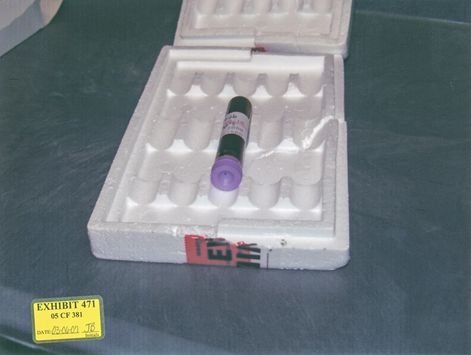The New Age of Forensic Science
Is Epigenetics the Solution to Sample Age Uncertainty?
“When you have eliminated the impossible, whatever remains, however improbable, must be the truth.”
- Sherlock Holmes
The Sign of the Four
Everyone Loves a Good Mystery
Whether your most recent run-in with the judicial system was jury duty or true crime television, our experience with criminal hearings and media have made us expect the prosecution to bring forward compelling DNA evidence against the defendant. But the seemingly omnipresent DNA testing that is now a gold standard for criminal cases was only first used in a forensic capacity in 1986.
Making Forensic History
After 15-year-old Dawn Ashworth was raped and murdered in 1986 England, police noticed similarities in the crime to an earlier attack in 1983. DNA samples were tested from both crime scenes and found to be a match. The main suspect of Ashworth’s case, Richard Buckland, had confessed to her murder, but not the attack from 3-years prior. Buckland’s DNA was tested, but did not match the samples from both crime scenes. This resulted in the first suspect to be cleared by DNA evidence.
To further their investigation, police utilized DNA fingerprinting and samples were collected from all the males in town. Thanks to that mass DNA collection and some town gossip, Colin Pitchfork was sampled and convicted of both crimes 6 months later.
Over the last 30 years, Forensic Science has developed into an entire field with progressively better biological tools and equipment. New scientific advancements continue to expand the realm of possibilities of DNA evidence in the industry.
One such realm is the information fidelity lost from aging samples. If a biological sample is collected at a crime scene, the DNA profile must be matched to a profile in the offender index. If there is no match, the DNA profile is stored in the forensic index and waits for a future match[1]. But human error and sample handling over time can cause contamination that can leave investigators and a jury unsure of the forensic evidence. Genotyping used at crime scenes cannot reveal the age of a sample. While forensic science has helped solve a countless number of cases, these aging constraints can be limiting. To fill this information gap, forensic scientists are engineering better biological and chemical tools and techniques.
State of Wisconsin v. Steven Avery

In 1996, blood samples were implicated in The State of Wisconsin v. Steven Avery. Nine years later in 2005, the same blood was implicated in the murder of a woman named Teresa Halback. There was a suspicion that the blood found at the 2005 crime scene was from the stored 1996 sample. A recent publication in Forensic Genomics used this case to take DNA fingerprinting to an exciting new level.
The study captured different DNA samples and performed bisulfite sequencing along with methylation computation to predict the blood’s age at the time of collection. Zymo Research’s EZ DNA Methylation-Lightning Kit was used for bisulfite conversion and preparation of whole-genome bisulfite sequencing libraries. Samples were sequenced and values were obtained and assessed by the Zymo Research Human DNAge Service team. The first set of samples were controls from a ‘mock’ crime scene, the second was the stored 1996 sample, and the third sample was from the 2005 Halbach case.
To confirm the reliability of the DNAge predictor, a mock crime scene was created using samples from 49 volunteers of known ages (22 to 80 years old). The samples were deposited on different surfaces inside a 1995 Toyota RAV4 (the same make and model as the car from the Avery Case). The mock crime scene showed a 96.3% overall correlation (R^2 =0.963) between the known and predicted ages of the samples. Furthermore, DNA methylation was shown to estimate age within a range of 2.5 to 3.5 years with a technical error of just ±1.2 years.
The remnant blood sample from 1996, which had been in storage for 20 years, was also tested using the same method. The DNA methylation estimate was 37.9 years for this sample. Blood drawn from Avery in 2016 was also deposited on the mock RAV4. It was estimated to be 52.4 years, while his actual age at this time was 54.9 years old. The sample with the greatest DNA concentration from the 2005 crime scene was tested using the same method and technician. The predicted age for this sample was 52.8 years old. Steven Avery was 43.4 years of age in 2005, and 34.5 in 1996. Given that the DNA methylation predictor was shown to never exceed a 10-year difference for any sample from neither the mock crime scene, nor a separate much larger cohort (n=195), it is most likely that the sample from the 2005 crime scene was from Steven Avery in 2005, not 1996.[2]
20 Years of Questions
Even after 20 years of storage, Avery’s 1996 crime scene sample measured 3.4 years away from Avery’s true age at the time. Sample collection device manufacturers have increased sample storage capabilities dramatically. The DNAge analysis has proven to be the first reliable method for estimating epigenetic age of a long-term storage sample in a forensic capacity. Modern DNA methylation testing for forensics might mean decades-old cold cases with stored biological samples might finally be cracked.
Check out the full article for more information.
References
- U.S. Department of Justice, N. C. (2001). Understanding DNA Evidence: A Guide for Victim Service Providers. Retrieved from Office for Victims of Crime: https://www.ojp.gov/pdffiles1/nij/bc000657.pdf
- Jonathan Foox, D. B. (2021). Epigenetic Forensics for Suspect Identification and Age Prediction. Forensic Genomics, 1(3), 83-86.


